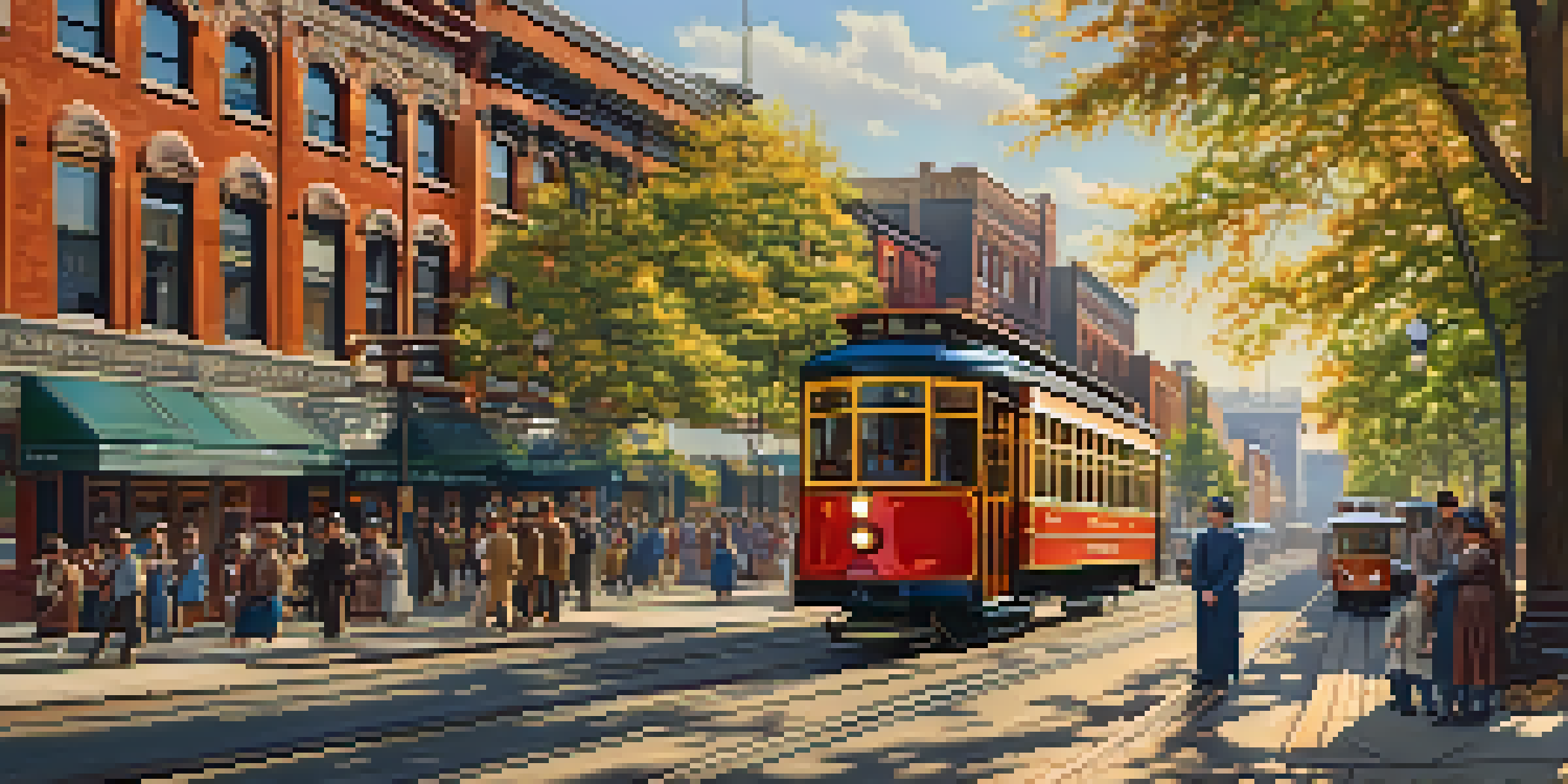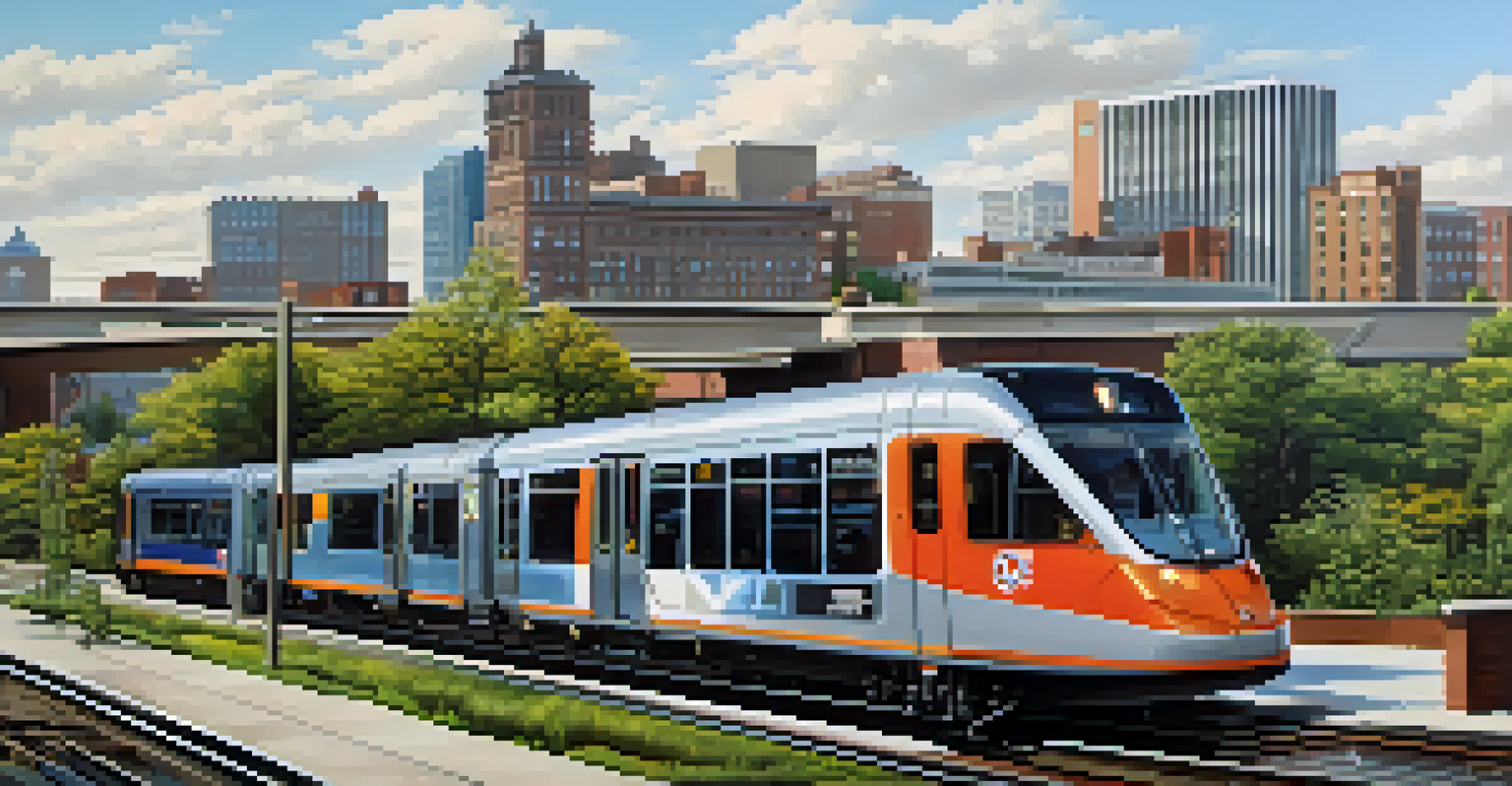The Rise and Fall of Buffalo's Streetcar System Explained

The Birth of Buffalo's Streetcar System in the 19th Century
Buffalo's streetcar system began to take shape in the late 1800s, driven by the city's rapid growth and the need for efficient transportation. The first horse-drawn streetcars appeared around 1860, providing a much-needed solution for residents to navigate the city's expanding landscape. This innovation was not just about convenience; it marked the beginning of a significant shift in urban mobility, making it easier for people to travel to work, school, and leisure activities.
Public transportation is a lifeline for urban communities, connecting people to opportunities and services.
As technology progressed, electric streetcars took over in the 1890s, revolutionizing public transit. The introduction of electric power meant streetcars could travel faster and further, opening up new neighborhoods and connecting more residents. This transition not only boosted the city's economy but also enhanced the overall quality of life, as people could now live farther from their workplaces without the burden of long commutes.
By the early 20th century, Buffalo's streetcar system was a bustling network that served thousands daily. It became a symbol of progress and modernity, reflecting the city's ambition to provide accessible transportation. The extensive routes crisscrossed Buffalo, making it one of the most comprehensive streetcar systems in the country at that time.
The Golden Age of Streetcars in Buffalo
The early to mid-20th century marked the golden age of Buffalo's streetcar system, with ridership peaking in the 1920s. The streetcars were not just a means of transportation; they became an integral part of Buffalo's identity. People relied on them for everyday travel, and the city thrived as neighborhoods developed around streetcar lines, fostering a sense of community and connectivity.

During this time, Buffalo's streetcars were celebrated for their efficiency and reliability. With frequent service and extensive routes, residents could easily access shopping districts, parks, and cultural institutions. This accessibility helped shape the urban landscape, contributing to the development of vibrant commercial and residential areas throughout the city.
Buffalo's Streetcar System Origins
Buffalo's streetcar system emerged in the late 1800s, evolving from horse-drawn cars to electric streetcars that transformed urban mobility.
However, as the popularity of automobiles surged in the post-World War II era, the future of the streetcar system began to look uncertain. The convenience of private vehicles changed the way people thought about transportation, leading to a gradual decline in streetcar ridership and a shift in urban planning priorities that favored road construction over public transit.
Challenges Faced by Buffalo's Streetcar System
Buffalo's streetcar system faced numerous challenges in the mid-20th century, primarily due to the rise of the automobile. As more people opted for personal vehicles, streetcar ridership began to dwindle, leading to financial strain on the transit system. This decline was further exacerbated by changing urban development patterns, which focused on suburban expansion and car-centric infrastructure.
Cities are like people. They can get old and tired, or they can find new life when they embrace change and innovation.
Additionally, the maintenance costs of the aging streetcar infrastructure became a burden for the city. Many streetcar lines required significant investment to remain operational, but with decreasing ridership, funding became increasingly difficult to secure. This financial instability led to cutbacks in service and, ultimately, the abandonment of many routes.
Public sentiment also shifted during this period. While streetcars had once been viewed as a modern convenience, they began to be associated with an outdated mode of transportation. This perception contributed to the push for more highways and roadways, further diminishing the streetcar system's relevance in Buffalo's transportation landscape.
The Decline and Dismantling of the System
By the 1950s, the decline of Buffalo's streetcar system became evident, with significant cuts to routes and services. The once-bustling streetcars that filled the city's streets were gradually replaced by buses and cars. This shift marked a critical turning point, as the city began dismantling the infrastructure that had been a lifeline for Buffalo residents for nearly a century.
The last streetcar line in Buffalo officially shut down in 1952, ending an era that had transformed urban transportation. This decision was met with mixed reactions from the public; while some welcomed the convenience of buses and cars, others lamented the loss of a beloved and historic mode of transit. The absence of streetcars changed the way people navigated the city and altered the urban landscape dramatically.
Challenges and Decline of Streetcars
The rise of automobiles led to a significant decline in streetcar ridership, financial strain, and the eventual dismantling of the system by the 1950s.
The dismantling of the streetcar system not only affected transportation but also had broader implications for the city's development and economy. As neighborhoods became more fragmented and reliant on car travel, the vibrant communities that had thrived around streetcar lines struggled to adapt to the new reality. This shift contributed to urban decline, leaving a lasting impact on Buffalo's social and economic fabric.
Modern Efforts to Revive Public Transit in Buffalo
In recent years, there has been a renewed interest in public transit solutions in Buffalo, as city officials and residents recognize the importance of sustainable transportation. Initiatives aimed at revitalizing public transit have gained traction, with discussions around reintroducing streetcars or light rail systems to enhance connectivity and reduce traffic congestion. This shift reflects a growing awareness of the need for efficient alternatives to car travel.
One notable project is the Buffalo Metro Rail, which opened in the 1980s and serves as a vital transportation option for residents. Although it doesn't directly replicate the old streetcar system, it represents a step towards modernizing public transit and addressing the challenges posed by urban sprawl. Community support for such projects indicates a desire to reclaim the accessibility and vibrancy that public transportation once provided.
Moreover, the push for sustainable transportation aligns with broader trends across the country, as cities aim to reduce carbon emissions and promote greener alternatives. By learning from the past and considering the lessons of the streetcar system's decline, Buffalo is working towards a future that prioritizes public transit as an essential component of urban life.
Lessons from the Rise and Fall of Buffalo's Streetcars
The rise and fall of Buffalo's streetcar system offer valuable lessons on urban planning and transportation. One key takeaway is the importance of adapting public transit to meet the changing needs of residents. As cities evolve, so too must their transportation systems, ensuring they remain relevant and accessible to all citizens. Ignoring these shifts can lead to decline, as seen in Buffalo's history.
Additionally, the story of Buffalo's streetcars highlights the need for a balanced approach to urban development. While automobiles have transformed transportation, over-reliance on cars can lead to traffic congestion, environmental issues, and urban sprawl. By finding a middle ground that supports both public transit and personal vehicles, cities can create more livable environments that foster community connections.
Reviving Public Transit in Buffalo
Recent efforts to revitalize public transit in Buffalo indicate a community interest in sustainable transportation solutions and modern infrastructure.
Lastly, the narrative of Buffalo's streetcar system emphasizes the importance of public engagement in transportation planning. When residents are involved in discussions about their transit needs, it can lead to more effective solutions that reflect the community's values. As Buffalo continues to navigate its transportation future, these lessons remain crucial for creating a system that serves everyone.
The Future of Public Transportation in Buffalo
Looking ahead, the future of public transportation in Buffalo holds promising potential. With increased investment in infrastructure and a focus on sustainability, there is hope for a revitalized transit system that includes modern streetcars or light rail options. Community interest in these projects suggests that residents are ready to embrace a new era of public transportation that prioritizes convenience and accessibility.
Furthermore, the integration of technology into public transit could enhance the overall experience for riders. Innovations such as real-time tracking, mobile ticketing, and improved service frequency can make public transportation more user-friendly and attractive. By leveraging technology, Buffalo can create a transit system that meets the demands of a modern urban landscape.

Ultimately, the rebirth of public transportation in Buffalo is about more than just getting from point A to point B. It represents a commitment to building a vibrant, connected community where residents can easily navigate their city. As Buffalo looks to the future, the lessons learned from its streetcar history will undoubtedly play a vital role in shaping a more inclusive and sustainable transportation landscape.